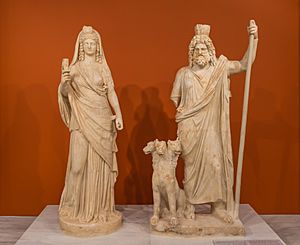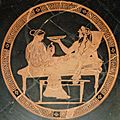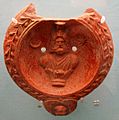Pluto (mythology) facts for kids
Pluto (pronounced PLOO-toh) was the powerful ruler of the Greek underworld in ancient myths. He was also known by an older name, Hades, which later became the common name for the underworld itself. People often thought of Pluto as the god of wealth, because valuable minerals are found deep underground. He also ruled the earth that held the seeds for good harvests.
Pluto is often shown with a scepter (a royal staff), keys, a throne, and horses. The keys represent his ability to give wealth to people, especially the rich harvests from the land. The dwarf planet Pluto was named after this god.

Contents
Myths of Pluto
Pluto appears in many famous stories. The best-known myth tells about his marriage to Persephone.
Pluto and Persephone: The Story of the Seasons
The most famous story about Pluto is how he took Persephone to be his wife. Persephone was the daughter of Ceres, the goddess of farming. Pluto brought Persephone to the underworld, which was his kingdom.
Ceres was so sad that she cried and would not let any plants grow on Earth. People needed plants to live, so the mighty god Jupiter stepped in. He made a deal with Pluto: Persephone would spend part of the year with Pluto in the underworld and part of the year with her mother on Earth.
When Persephone was in the underworld, no plants could grow, and it was winter. When she returned to her mother, plants grew again, and it was summer. This is how the Romans explained the changing seasons. Pluto also had a loyal, three-headed dog named Cerberus. Cerberus guarded the gates to the underworld.
Pluto and Orpheus: A Journey for Love
Another myth featuring Pluto is the sad tale of Orpheus and Eurydice. Orpheus loved his wife, Eurydice, very much. On their wedding day, Eurydice was bitten by a viper and died instantly.
Orpheus was heartbroken. He played and sang such sorrowful songs that even the gods and nymphs cried. They told him to go to the Underworld to bring Eurydice back.
Orpheus bravely went to the underworld. He hoped to charm Pluto and Persephone with his beautiful music. Orpheus's music was so powerful that it softened the hearts of Pluto and Persephone. Pluto, who rarely showed emotion, allowed Eurydice to return with Orpheus.
However, there was one rule: Orpheus had to walk in front of Eurydice and not look back until they both reached the upper world. Orpheus started his journey, with Eurydice following behind. But as soon as he stepped into the upper world, he turned to look at her. He forgot that both of them needed to be out of the underworld for the rule to be met. Because Eurydice had not yet crossed into the upper world, she vanished forever.
Pluto in Art
Artists often showed the story of Pluto taking Persephone. This scene was very popular in fine art.
Some famous artists who created works about Pluto include:
- Albrecht Dürer: Abduction of Proserpine on a Unicorn (1516), an etching. This artwork shows Pluto taking Persephone on a unicorn, which was a very unusual idea.
- Caravaggio: Jupiter, Neptune, and Pluto (around 1597), a painting on a ceiling. This painting shows the three gods floating around a globe. Pluto is with a bluish-gray horse and a three-headed dog that looks like a Border Collie.
- Jan Brueghel the Elder: Orpheus before Pluto and Proserpina (1604), a painting.
- Bernini: Pluto and Proserpina (1621–22), a famous sculpture. It shows Cerberus looking in three different directions.
- Rembrandt: Abduction of Proserpina (around 1631), a painting. Rembrandt's Pluto looks like a powerful lion.
Related pages
- Hades - The Greek god who is very similar to Pluto.
Images for kids
-
A mosaic from the Kasta Tomb in Amphipolis showing Pluto taking Persephone, from the 4th century BC.
-
Hades and Persephone on a red-figured kylix (drinking cup), around 440–430 BC.
-
The narcissus flower, often linked to the myth of Persephone. She was picking these flowers when Hades took her to the Underworld.
-
Persephone and Pluto (or Hades) on a pinax from Locri.
See also
 In Spanish: Plutón (mitología) para niños
In Spanish: Plutón (mitología) para niños






